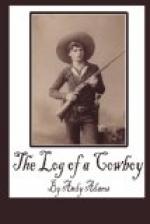The water was shallow as we entered, and we reached nearly the middle of the river before the loose saddle horses struck swimming water. Honeyman was on their lee, and with the cattle crowding in their rear, there was no alternative but to swim. A loose horse swims easily, however, and our remuda readily faced the current, though it was swift enough to carry them below the passageway on the opposite side. By this time the lead cattle were adrift, and half a dozen of us were on their lower side, for the footing under the cutbank was narrow, and should the cattle become congested on landing, some were likely to drown. For a quarter of an hour it required cool heads to keep the trail of cattle moving into the water and the passageway clear on the opposite landing. While they were crossing, the herd represented a large letter “U,” caused by the force of the current drifting the cattle downstream, or until a foothold was secured on the farther side. Those of us fortunate enough to have good swimming horses swam the river a dozen times, and then after the herd was safely over, swam back to get our clothing. It was a thrilling experience to us younger lads of the outfit, and rather attractive; but the elder and more experienced men always dreaded swimming rivers. Their reasons were made clear enough when, a fortnight later, we crossed Red River, where a newly made grave was pointed out to us, amongst others of men who had lost their lives while swimming cattle.
Once the bulk of the cattle were safely over, with no danger of congestion on the farther bank, they were allowed to loiter along under the cutbank and drink to their hearts’ content. Quite a number strayed above the passageway, and in order to rout them out, Bob Blades, Moss Strayhorn, and I rode out through the outlet and up the river, where we found some of them in a passageway down a dry arroyo. The steers had found a soft, damp place in the bank, and were so busy horning the waxy, red mud, that they hardly noticed our approach until we were within a rod of them. We halted our horses and watched their antics. The kneeling cattle were cutting the bank viciously with their horns and matting their heads with the red mud, but on discovering our presence, they curved their tails and stampeded out as playfully as young lambs on a hillside.




